Challenges
ERP transformation in environmental technology: Strategic process optimization with measurable business benefits
Initial situation
A global manufacturer of environmental protection equipment and recycling containers faced the strategic challenge of modernizing its legacy IT structures. Fragmented Excel landscapes, a lack of system integration between CAD and machine controls, and inadequate integration with financial accounting were hampering operational efficiency.
Solution
Strategic approach
The transformation followed a structured, three-stage approach: First, a systematic analysis of existing business processes was conducted, identifying specific areas for improvement. These findings were then translated into a future-oriented IT strategy in collaboration with management. The developed specifications defined precise requirements for interface integration, future viability, and integration with human resources management as the foundation for the ERP selection.
Quantified successes
The implemented solution achieved measurable improvements in all core areas:
- 85% Reduction in the Excel-based work processes
- 15% Reduction on order processing times
- 12% Optimisation of material stocks through stringent supply chain planning
Strategic success factors
The project's success was based on the consistent integration of business process reengineering and technological implementation. The early involvement of management in strategy development ensured organizational acceptance and enabled consistent process optimization.
This case study demonstrates how methodical ERP consulting goes beyond mere software selection and creates sustainable business benefits through strategic process innovation.
Key Points
-
Strategic Process Transformation
Overhauled manual Excel-based workflows and integrated fragmented systems, enabling smoother coordination across CAD, machine controls, and financial accounting. -
Measurable Efficiency Gains
Delivered significant performance improvements—including an 85% reduction in Excel-driven processes, 15% faster order processing, and 12% better material stock efficiency through advanced supply chain planning. -
Three-Phase, Collaborative Approach
Executed a structured, three-stage methodology—starting with detailed process analysis, followed by collaborative IT strategy development, and culminating in precise ERP requirements and integration planning. -
Enduring, Sustainable Benefits
The project extended beyond software implementation to enable enduring business benefits, prioritising process innovation over simple system deployment.

Global Manufacturer
Number of Employees Customer FocusA global manufacturer of environmental protection equipment and recycling containers faced the strategic challenge of modernizing its legacy IT structures. Fragmented Excel landscapes, a lack of system integration between CAD and machine controls, and inadequate integration with financial accounting were hampering operational efficiency.


